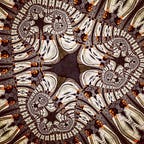The most Creative Code thus far Writes, Directs, and Produces a Short Film Using AI
After several months of speechless conversations with OpenAI’s GPT-3 and more recently with an adaptation of their CLIPS to translate text to image, I am dumbfounded by what an autonomous AI is capable of producing, all by itself.
Before going any further with the outcome of this experiment it might be within the reader’s best interest that I introduce you to the artist and scientist, ALAgrApHY behind this and put his research and interest on the map.
ALAgrApHY is a Paris-based cosmopolitan artist (filmmaker, painter, photographer, digital artist) and scientist (PhD in complex systems, data scientist, Postdoc in NLP and information extraction) who is fascinated by the interplay between arts and science. Before the internet witnessed a buzz in AI ART with Christie’s sale, ALAgrApHY exhibited AI-generated art mosaics at the Grand Palais and won the digital art award of the Salon d’Automne that started the cubism and fauvism movements. He has given a few talks of which I recommend the TEDx ones that summarize neatly what he does. In many of his talks, he repeatedly insists that AI is a tool that is far from being creative autonomously. However, his most recent results have unveiled the dawning of a creative AI but with a catch that I will discuss below.
I discuss GPT-3 at length in another post with several examples but for now, let’s define it as a very advanced text generator that has been dubbed as the Most Powerful Artificial Intelligence Tool in the World by Entrepreneur magazine. ALAgrApHY is one of the testers of the beta version made possible by OpenAI and for the sake of keeping things simple, we will go over only one of the millions of possible examples this powerful tool is capable of producing using only a seed of text that is to be automatically completed by AI. The example below is based on the seed “Yeti Tardigrade”.
Notice how the word Yeti is no longer mentioned in the generated text, however, the Yetiness is and is reflected in the hairiness! The text generation could be repeated every time leading to a new outcome. What we have chosen here is a very simple outcome that along with the keywords “Yeti Tardigrade” should be enough to generate enough visual complexity as I will illustrate below.
Again, that is a very simple example of what GPT-3 is capable of. In another post I show more complex GPT-3 studies that are formatted as film scripts and could add to the complexity of the visuals you are about to see next.
The visual part is based on a text-to-image abstraction tool known as CLIPS. One of its applications is DALL-E which can grasp concepts from text and paint them into images. Another implementation uses Big Sleep Gan by Ryan Murdock to do the same. The video that is based on the Tardigrade Yeti you are about to see uses both open-source codes and adds iterative re-seeding that are all parametrizable.
What fascinates me in this video is the abstraction capacity of CLIPS that is capable not only of drawing tardigrades from scratch but adding hair or fur to their grizzly soft microscopic bodies. What is also fascinating is the snow aspect that comes from the Yetiness of all this. It feels as if these hairy tardigrades live in the north pole.
Could anything be any more fascinating?
As for creativity, this surely brings a huge surprise to the author as well as to the viewer in terms of conception as well as execution. However, the idea of a YETI TARDIGRADE was not conceived by AI. Furthermore, the GPT-3 text was not the first one generated. A couple of texts were committed until one seemed worth being produced visually.
The real question concerning creative AI is: “How far are we from having an AI capable of generating sensible concepts and rendering them in ways that can touch us?”. Notice that I did not say meaningful concepts though “Yeti Tardigrades” can be arguably meaningful. Great artists, poets, and writers are not necessarily understood but definitely felt.
1000 monkeys typing on a keyboard for 100 years might eventually type one of Shakespear’s plays. That does not make a monkey a creative writer although monkeys have exceptional creativity in other fields. Likewise, one can argue that an AI trying to stimulate one’s neurons by random generation is no measure for creativity, well, until this random vanishes or surpasses that of human’s trial and error with empathy and incredibly fast learning rates. In previous posts, I discussed AI-generated faces, AI-generated cats, AI-generated Airbnb listings, and almost about anything one can or cannot imagine, however, this is more general of an AI than GAI we’ve encountered before.
Thank you for reading. Thank you for sharing!
This article was written by ALAgrApHY in its entirety and not by a bot! =)
EDIT: I have recently published an article about a RANDOM POEM, written, read and animated by AI. Check it out.
If you wish to support my research and development you can surely find a way!
